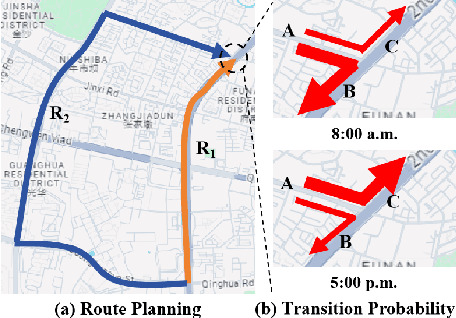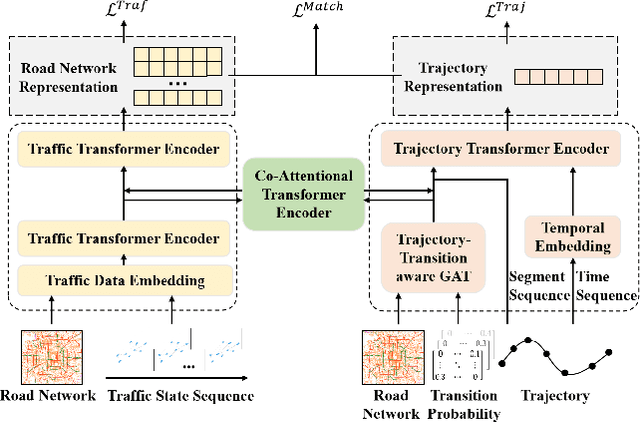Junjie Wu
Mindscape-Aware Retrieval Augmented Generation for Improved Long Context Understanding
Dec 19, 2025Abstract:Humans understand long and complex texts by relying on a holistic semantic representation of the content. This global view helps organize prior knowledge, interpret new information, and integrate evidence dispersed across a document, as revealed by the Mindscape-Aware Capability of humans in psychology. Current Retrieval-Augmented Generation (RAG) systems lack such guidance and therefore struggle with long-context tasks. In this paper, we propose Mindscape-Aware RAG (MiA-RAG), the first approach that equips LLM-based RAG systems with explicit global context awareness. MiA-RAG builds a mindscape through hierarchical summarization and conditions both retrieval and generation on this global semantic representation. This enables the retriever to form enriched query embeddings and the generator to reason over retrieved evidence within a coherent global context. We evaluate MiA-RAG across diverse long-context and bilingual benchmarks for evidence-based understanding and global sense-making. It consistently surpasses baselines, and further analysis shows that it aligns local details with a coherent global representation, enabling more human-like long-context retrieval and reasoning.
HiEAG: Evidence-Augmented Generation for Out-of-Context Misinformation Detection
Nov 18, 2025Abstract:Recent advancements in multimodal out-of-context (OOC) misinformation detection have made remarkable progress in checking the consistencies between different modalities for supporting or refuting image-text pairs. However, existing OOC misinformation detection methods tend to emphasize the role of internal consistency, ignoring the significant of external consistency between image-text pairs and external evidence. In this paper, we propose HiEAG, a novel Hierarchical Evidence-Augmented Generation framework to refine external consistency checking through leveraging the extensive knowledge of multimodal large language models (MLLMs). Our approach decomposes external consistency checking into a comprehensive engine pipeline, which integrates reranking and rewriting, apart from retrieval. Evidence reranking module utilizes Automatic Evidence Selection Prompting (AESP) that acquires the relevant evidence item from the products of evidence retrieval. Subsequently, evidence rewriting module leverages Automatic Evidence Generation Prompting (AEGP) to improve task adaptation on MLLM-based OOC misinformation detectors. Furthermore, our approach enables explanation for judgment, and achieves impressive performance with instruction tuning. Experimental results on different benchmark datasets demonstrate that our proposed HiEAG surpasses previous state-of-the-art (SOTA) methods in the accuracy over all samples.
MMD-Thinker: Adaptive Multi-Dimensional Thinking for Multimodal Misinformation Detection
Nov 17, 2025Abstract:Multimodal misinformation floods on various social media, and continues to evolve in the era of AI-generated content (AIGC). The emerged misinformation with low creation cost and high deception poses significant threats to society. While recent studies leverage general-purpose multimodal large language models (MLLMs) to achieve remarkable results in detection, they encounter two critical limitations: (1) Insufficient reasoning, where general-purpose MLLMs often follow the uniform reasoning paradigm but generate inaccurate explanations and judgments, due to the lack of the task-specific knowledge of multimodal misinformation detection. (2) Reasoning biases, where a single thinking mode make detectors a suboptimal path for judgment, struggling to keep pace with the fast-growing and intricate multimodal misinformation. In this paper, we propose MMD-Thinker, a two-stage framework for multimodal misinformation detection through adaptive multi-dimensional thinking. First, we develop tailor-designed thinking mode for multimodal misinformation detection. Second, we adopt task-specific instruction tuning to inject the tailored thinking mode into general-purpose MLLMs. Third, we further leverage reinforcement learning strategy with a mixed advantage function, which incentivizes the reasoning capabilities in trajectories. Furthermore, we construct the multimodal misinformation reasoning (MMR) dataset, encompasses more than 8K image-text pairs with both reasoning processes and classification labels, to make progress in the relam of multimodal misinformation detection. Experimental results demonstrate that our proposed MMD-Thinker achieves state-of-the-art performance on both in-domain and out-of-domain benchmark datasets, while maintaining flexible inference and token usage. Code will be publicly available at Github.
Graph-R1: Incentivizing the Zero-Shot Graph Learning Capability in LLMs via Explicit Reasoning
Aug 24, 2025



Abstract:Generalizing to unseen graph tasks without task-pecific supervision remains challenging. Graph Neural Networks (GNNs) are limited by fixed label spaces, while Large Language Models (LLMs) lack structural inductive biases. Recent advances in Large Reasoning Models (LRMs) provide a zero-shot alternative via explicit, long chain-of-thought reasoning. Inspired by this, we propose a GNN-free approach that reformulates graph tasks--node classification, link prediction, and graph classification--as textual reasoning problems solved by LRMs. We introduce the first datasets with detailed reasoning traces for these tasks and develop Graph-R1, a reinforcement learning framework that leverages task-specific rethink templates to guide reasoning over linearized graphs. Experiments demonstrate that Graph-R1 outperforms state-of-the-art baselines in zero-shot settings, producing interpretable and effective predictions. Our work highlights the promise of explicit reasoning for graph learning and provides new resources for future research.
DALIP: Distribution Alignment-based Language-Image Pre-Training for Domain-Specific Data
Apr 02, 2025Abstract:Recently, Contrastive Language-Image Pre-training (CLIP) has shown promising performance in domain-specific data (e.g., biology), and has attracted increasing research attention. Existing works generally focus on collecting extensive domain-specific data and directly tuning the original CLIP models. Intuitively, such a paradigm takes no full consideration of the characteristics lying in domain-specific data (e.g., fine-grained nature of biological data) and so limits model capability, while mostly losing the original ability of CLIP in the general domain. In this paper, we propose a Distribution Alignment-based Language-Image Pre-Training (DALIP) method for biological data. Specifically, DALIP optimizes CLIP models by matching the similarity between feature distribution of image-text pairs instead of the original [cls] token, which can capture rich yet effective information inherent in image-text pairs as powerful representations, and so better cope with fine-grained nature of biological data. Particularly, our DALIP efficiently approximates feature distribution via its first- and second-order statistics, while presenting a Multi-head Brownian Distance Covariance (MBDC) module to acquire second-order statistics of token features efficiently. Furthermore, we collect a new dataset for plant domain (e.g., specific data in biological domain) comprising 10M plant data with 3M general-domain data (namely PlantMix-13M) according to data mixing laws. Extensive experiments show that DALIP clearly outperforms existing CLIP counterparts in biological domain, while well generalizing to remote sensing and medical imaging domains. Besides, our PlantMix-13M dataset further boosts performance of DALIP in plant domain, while preserving model ability in general domain.
BeMERC: Behavior-Aware MLLM-based Framework for Multimodal Emotion Recognition in Conversation
Mar 31, 2025Abstract:Multimodal emotion recognition in conversation (MERC), the task of identifying the emotion label for each utterance in a conversation, is vital for developing empathetic machines. Current MLLM-based MERC studies focus mainly on capturing the speaker's textual or vocal characteristics, but ignore the significance of video-derived behavior information. Different from text and audio inputs, learning videos with rich facial expression, body language and posture, provides emotion trigger signals to the models for more accurate emotion predictions. In this paper, we propose a novel behavior-aware MLLM-based framework (BeMERC) to incorporate speaker's behaviors, including subtle facial micro-expression, body language and posture, into a vanilla MLLM-based MERC model, thereby facilitating the modeling of emotional dynamics during a conversation. Furthermore, BeMERC adopts a two-stage instruction tuning strategy to extend the model to the conversations scenario for end-to-end training of a MERC predictor. Experiments demonstrate that BeMERC achieves superior performance than the state-of-the-art methods on two benchmark datasets, and also provides a detailed discussion on the significance of video-derived behavior information in MERC.
The Stochastic Parrot on LLM's Shoulder: A Summative Assessment of Physical Concept Understanding
Feb 13, 2025



Abstract:In a systematic way, we investigate a widely asked question: Do LLMs really understand what they say?, which relates to the more familiar term Stochastic Parrot. To this end, we propose a summative assessment over a carefully designed physical concept understanding task, PhysiCo. Our task alleviates the memorization issue via the usage of grid-format inputs that abstractly describe physical phenomena. The grids represents varying levels of understanding, from the core phenomenon, application examples to analogies to other abstract patterns in the grid world. A comprehensive study on our task demonstrates: (1) state-of-the-art LLMs, including GPT-4o, o1 and Gemini 2.0 flash thinking, lag behind humans by ~40%; (2) the stochastic parrot phenomenon is present in LLMs, as they fail on our grid task but can describe and recognize the same concepts well in natural language; (3) our task challenges the LLMs due to intrinsic difficulties rather than the unfamiliar grid format, as in-context learning and fine-tuning on same formatted data added little to their performance.
Understanding LLMs' Fluid Intelligence Deficiency: An Analysis of the ARC Task
Feb 11, 2025



Abstract:While LLMs have exhibited strong performance on various NLP tasks, it is noteworthy that most of these tasks rely on utilizing the vast amount of knowledge encoded in LLMs' parameters, rather than solving new problems without prior knowledge. In cognitive research, the latter ability is referred to as fluid intelligence, which is considered to be critical for assessing human intelligence. Recent research on fluid intelligence assessments has highlighted significant deficiencies in LLMs' abilities. In this paper, we analyze the challenges LLMs face in demonstrating fluid intelligence through controlled experiments, using the most representative ARC task as an example. Our study revealed three major limitations in existing LLMs: limited ability for skill composition, unfamiliarity with abstract input formats, and the intrinsic deficiency of left-to-right decoding. Our data and code can be found in https://wujunjie1998.github.io/araoc-benchmark.github.io/.
Bridging Traffic State and Trajectory for Dynamic Road Network and Trajectory Representation Learning
Feb 08, 2025



Abstract:Effective urban traffic management is vital for sustainable city development, relying on intelligent systems with machine learning tasks such as traffic flow prediction and travel time estimation. Traditional approaches usually focus on static road network and trajectory representation learning, and overlook the dynamic nature of traffic states and trajectories, which is crucial for downstream tasks. To address this gap, we propose TRACK, a novel framework to bridge traffic state and trajectory data for dynamic road network and trajectory representation learning. TRACK leverages graph attention networks (GAT) to encode static and spatial road segment features, and introduces a transformer-based model for trajectory representation learning. By incorporating transition probabilities from trajectory data into GAT attention weights, TRACK captures dynamic spatial features of road segments. Meanwhile, TRACK designs a traffic transformer encoder to capture the spatial-temporal dynamics of road segments from traffic state data. To further enhance dynamic representations, TRACK proposes a co-attentional transformer encoder and a trajectory-traffic state matching task. Extensive experiments on real-life urban traffic datasets demonstrate the superiority of TRACK over state-of-the-art baselines. Case studies confirm TRACK's ability to capture spatial-temporal dynamics effectively.
Learning Universal Multi-level Market Irrationality Factors to Improve Stock Return Forecasting
Feb 07, 2025Abstract:Recent years have witnessed the perfect encounter of deep learning and quantitative trading has achieved great success in stock investment. Numerous deep learning-based models have been developed for forecasting stock returns, leveraging the powerful representation capabilities of neural networks to identify patterns and factors influencing stock prices. These models can effectively capture general patterns in the market, such as stock price trends, volume-price relationships, and time variations. However, the impact of special irrationality factors -- such as market sentiment, speculative behavior, market manipulation, and psychological biases -- have not been fully considered in existing deep stock forecasting models due to their relative abstraction as well as lack of explicit labels and data description. To fill this gap, we propose UMI, a Universal multi-level Market Irrationality factor model to enhance stock return forecasting. The UMI model learns factors that can reflect irrational behaviors in market from both individual stock and overall market levels. For the stock-level, UMI construct an estimated rational price for each stock, which is cointegrated with the stock's actual price. The discrepancy between the actual and the rational prices serves as a factor to indicate stock-level irrational events. Additionally, we define market-level irrational behaviors as anomalous synchronous fluctuations of stocks within a market. Using two self-supervised representation learning tasks, i.e., sub-market comparative learning and market synchronism prediction, the UMI model incorporates market-level irrationalities into a market representation vector, which is then used as the market-level irrationality factor.
 Add to Chrome
Add to Chrome Add to Firefox
Add to Firefox Add to Edge
Add to Edge